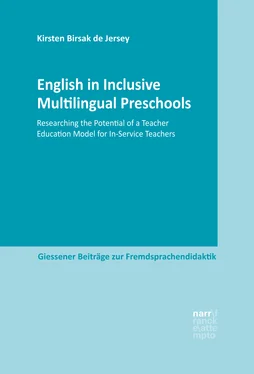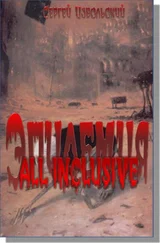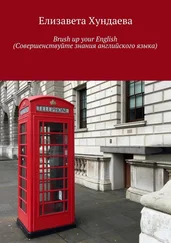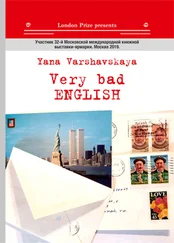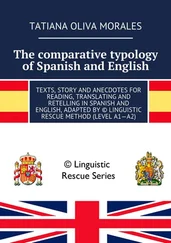Kirsten Birsak de Jersey - English in Inclusive Multilingual Preschools
Здесь есть возможность читать онлайн «Kirsten Birsak de Jersey - English in Inclusive Multilingual Preschools» — ознакомительный отрывок электронной книги совершенно бесплатно, а после прочтения отрывка купить полную версию. В некоторых случаях можно слушать аудио, скачать через торрент в формате fb2 и присутствует краткое содержание. Жанр: unrecognised, на английском языке. Описание произведения, (предисловие) а так же отзывы посетителей доступны на портале библиотеки ЛибКат.
- Название:English in Inclusive Multilingual Preschools
- Автор:
- Жанр:
- Год:неизвестен
- ISBN:нет данных
- Рейтинг книги:3 / 5. Голосов: 1
-
Избранное:Добавить в избранное
- Отзывы:
-
Ваша оценка:
- 60
- 1
- 2
- 3
- 4
- 5
English in Inclusive Multilingual Preschools: краткое содержание, описание и аннотация
Предлагаем к чтению аннотацию, описание, краткое содержание или предисловие (зависит от того, что написал сам автор книги «English in Inclusive Multilingual Preschools»). Если вы не нашли необходимую информацию о книге — напишите в комментариях, мы постараемся отыскать её.
English in Inclusive Multilingual Preschools — читать онлайн ознакомительный отрывок
Ниже представлен текст книги, разбитый по страницам. Система сохранения места последней прочитанной страницы, позволяет с удобством читать онлайн бесплатно книгу «English in Inclusive Multilingual Preschools», без необходимости каждый раз заново искать на чём Вы остановились. Поставьте закладку, и сможете в любой момент перейти на страницу, на которой закончили чтение.
Интервал:
Закладка:
One consequence of training kindergarten teachers at secondary level (to date) in Austria has been that Austrian universities and research institutions (with a few exceptions) have occupied themselves little or not at all, with research referring to the kindergarten age group. The same is true, more or less, of the question of how 3 to 6 year olds relate to languages, or deal with various different languages. (Council of Europe, 2008a, p. 87)
Legutke et al. (2009) in their methodology for teaching English in the primary and preschool state that insights resulting from pilots in English language education (p. 140) are limited as research is conducted in exclusive language learning contexts:
[The results] were obtained with a predominantly monolingual group of German children. No pilots have been reported about multi-lingual groups of children, which today have become dominant in many urban and even rural areas. What is missing so far are … programs that consider all children of a given area. In conjunction with these pilots, the impact of factors such as diverse cultural and linguistic backgrounds, social status, and economic status of parents would have to be researched. (p. 141)
In some studies, that are situated in more privileged contexts, the issue of how to qualify teachers for preschools that “grant learning opportunities to all students, no matter what language and cultural background they have” (p. 141) is not addressed. A case in point is a recent study conducted by Seifert (2016). Her sample is a German-English bilingual elementary nursery school for one- to three-year-old children, which is attached to a university and therefore draws 90 % of its children from parents whose background is academic. As the author critically states herself, this sample hardly qualifies as representing the children currently attending elementary education (pp. 159-160). Other studies that are extensively documented on early language learning education are also located in bilingual acquisition contexts (Steinlein & Piske, 2016). The argument for introducing early English in a multilingual inclusive state preschool therefore cannot be directly derived from existing empirical research studies of documented successes of early English even though existing research in related primary and immersive elementary contexts at least implies that its introduction may be potentially worthwhile. However, a further argument strongly supports its introduction: it is the unquestionable need to provide equal learning opportunities for all the children :
Angesichts der Bildungsverantwortung des Elementarbereichs muss ernsthaft diskutiert werden, ob dem Kontakt mit einer ersten Fremdsprache … nicht selbstverständlich ein Platz zugestanden werden sollte. … Die Nachfrage nach kommerziellen Angeboten und Kindergärten mit bilingualen Programmen, deren Zahl sich in den letzten zehn Jahren verdreifacht haben soll, spiegelt den Elternwunsch. Da dieses Angebot aber nicht allen Kindern zugänglich ist, könnte in einem zentralen Entwicklungsbereich Chancenungleichheit entstehen. (Sambanis, 2016, p. 175)
Finally, yet importantly, it is with the background of my long-term experience and documented best practice examples of teaching English to all the children in the multilingual inclusive preschool that has motivated me to embark on this study (→ chapter 1.2). Its focus will be on the potential to develop preschool teachers’ competences to teach English, also because
many experts have emphasized that focusing on starting age as the key variable is misleading in foreign language contexts. The age factor is not the main issue. There is a lot more to success over time. The quality and quantity of early provision, teachers, programs, and continuity are more important. (Nikolov, 2016, p. 4; see also Nikolov, 2000; Singleton, 2014)
As the qualification of teachers, child-appropriate early language learning programs and the continuity of language programs (for example from preschool to primary education, and from primary education to secondary education) are believed to be just as important to successfully implement early language education as is the age factor, the next chapter will look more closely at the situation of foreign language learning in preschool as seen from the perspectives of education policy (both European and Austrian) and preschool teachers.
2.2 Recommendations of education policy for the preschool level
2.2.1 The European Commission’s recommendations
Chapter 2.2.1 looks at the official European Commission’s policy recommendations of early language teaching and learning which includes specific recommendations in its country report of the circumstances in Austria (Council of Europe, 2008a) and the Commission’s Policy Handbook on preschool in early language learning (European Commission, 2011a).
A significant break-through has come about across European membership states with the recognition that preschool is to be regarded as the first level of early childhood education, which children should attend:
Pre-school education in general has been the object of increased attention in recent years: with the aim of unlocking children’s potential, in 2009 the EU Education Ministers set a target that by 2020 at least 95 % of children aged between four and the age in which compulsory primary education starts should participate in early childhood education. (European Commission, 2011a, p. 5)
Within the move towards early childhood education, early language learning has taken a prominent position. Endorsing early language learning, the European Commission compiled the policy handbook (2011a) on language learning at the pre-primary level, in which it clearly states what early language learning entails:
‘Early Language Learning (ELL) at pre-primary level’ means systematic awareness raising or exposure to more than one language taking place in an early childhood education and care setting in a pre-primary school context. (p. 6; italics in the original)
Early language learning policies include both second language learning, which is the language of instruction (in the context of the study presented here: German), and foreign language learning (in the context of the study presented here: English) (p. 5). To avoid any confusion on what the European Commission is referring to, there are clear definitions:
‘Second language’ means the language of instruction for children with a minority background, if it is different from their first language / mother tongue. It means the language of instruction in the case of children with a migrant background. In multilingual countries, it means the language of instruction when it is different from the children’s first language / mother tongue. (p. 7; italics in original)
Language of instruction means the dominant language formally used in the pre-primary school setting. (p. 6; italics in original)
First language / mother tongue means any language first acquired by a child. (p. 6; italics in original)
Foreign language means any language used in the pre-primary school context other than the first language / mother tongue, the language of instruction or the second language. (p. 7; italics in original)
This policy handbook addresses member states, giving a set of guidelines and recommendations of “reflecting examples of good practice and academic evidence on how to ensure the quality, effectiveness and sustainability of language learning in pre-primary settings” (p. 4). As there is a continual debate about early language learning, the policy handbook clearly establishes the benefits:
ELL activities in pre-primary settings … are instrumental in enhancing competences such as comprehension, expression, communication and problem-solving, enabling children to interact successfully with peers and adults. As young children also become aware of their own identity and cultural values, early language learning can shape the way they develop their attitudes towards other languages and cultures by raising awareness of diversity and of cultural variety, hence fostering understanding and respect. …
Читать дальшеИнтервал:
Закладка:
Похожие книги на «English in Inclusive Multilingual Preschools»
Представляем Вашему вниманию похожие книги на «English in Inclusive Multilingual Preschools» списком для выбора. Мы отобрали схожую по названию и смыслу литературу в надежде предоставить читателям больше вариантов отыскать новые, интересные, ещё непрочитанные произведения.
Обсуждение, отзывы о книге «English in Inclusive Multilingual Preschools» и просто собственные мнения читателей. Оставьте ваши комментарии, напишите, что Вы думаете о произведении, его смысле или главных героях. Укажите что конкретно понравилось, а что нет, и почему Вы так считаете.
